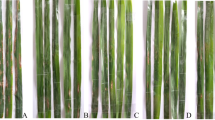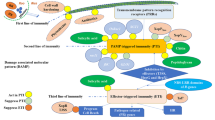Abstract
Upland rice cultivars were evaluated in the greenhouse for susceptibility to the rice blast disease caused by Pyricularia grisea Sacc., on two upland soils from the Philippines previously considered to be “blast conducive” and “blast non-conducive”. Under monocyclic inoculation tests plants grown in conducive soil showed significantly greater lesion development than plants of the same cultivar grown in non-conducive soil: cultivars considered to be susceptible to the isolates used showed increased number of susceptible-type lesions; resistant cultivars showed increased number of hypersensitive resistant-type lesions. A similar effect was observed under polycyclic tests where several generations of the pathogen were allowed to develop on the test plants. Dilution of conducive soil with non-conducive soil resulted in a corresponding reduction of disease severity, although this was most pronounced on resistant cultivars. Removal of leaf epicuticular waxes (LEW) using organic solvents increased the number of resistant-type lesions on resistant cultivars grown in both soils following inoculation. Susceptible plants were not suitable for quantifying the relative blast conduciveness of a soil because of the extreme environmental sensitivity of the bioassay and the tendency of lesions to coalesce.
Comparing numbers of resistant-type lesions on leaves of plants stripped of LEW and inoculated with an incompatible P. grisea isolate among plants grown in different soils proved to be a satisfactory means of distinguishing the relative blast conduciveness of soils under controlled conditions. This method was field tested in eastern India and results corroborated farmer assessment of which soils were blast conducive. Using incompatible isolate-cultivar combinations and LEW-free leaves is proposed as a simple bioassay for assessing blast conduciveness of soils and should prove useful in regional characterization of rice blast risk.
Similar content being viewed by others
References
Atkins J G 1974 Rice Diseases of Americas. A review of literature. Agriculture Handbook No. 448. ARS-USDA, Washington, USA. 103 p.
Bhatta J C and Singh R A 1992 Rice blast. In Plant Diseases of International Importance. Vol. I. Diseases of Cereals and Pulses. Eds. U SSingh, H SChaube, JKumar and A NMukhopadhyay. pp 80–115. Prentice Hall, New Jersey.
Bonman J M 1990 Host plant resistance for the rice blast management in the tropics. Paper presented at the Third International Conference on Plant Protection in the Tropics, 20–23 March 1990, Kuala Lumpur, Malaysia. 12 p.
Chuke K C, Nuque F L and Castro R 1979 Rice blast incidence in different soil types. Int. Rice Res. Newsl. 4(6), 11–12.
Datnoff L E, Raid R N, Snyder G H and Jones D B 1991 Effect of calcium silicate on blast and brown spot intensities and yields of rice. Plant Dis. 75, 729–732.
Gomez K A, Bartolome V I, Ulpindo E C and Calinga R T 1992 IRRISTAT User's Manual: Version 92–1. International Rice Research Institute, Los Bar-los, Laguna, Philippines.
Gupta P C and O'Toole J C 1986 Upland Rice: A global perspective. International Rice Research Institute, P.O. Box 933, Manila, Philippines. 360 p.
Kim C K and Lee S C 1982 Reduction of the incidence of rice neck blast by integrated soil improvement practice. Korean J. Plant Prot. 21, 15–18.
Kuerschner E, Silla R O and Bonman J M 1989 Effect of weed control in crop growth and development of blast and sheath blight in upland rice. Paper presented at the 20th Anniversary and Annual Convention of Pest Control Council of Philippines, Baguio, 9–12 May 1989.
Kuerschner E, Bonman J M, Garrity D P, Neue H U, Tamisin M M, Estrada B A and Quijano C 1990 Effects of some cultural practices on blast disease and rice yield at an acid upland site. Paper presented at the Third International Conference on Plant Protection in the Tropics, 20–23 March 1990, Kuala Lumpur, Malaysia.
Notteghem J L 1979 Application en Afrique des methodes de lutte contre la Pyriculariose. Communication presentée au Seminaire ADRAO “Les integrees de lutte contre les insectes parasites et les maladies du riz en method des environmental factors and plant age on the Afrique de l'Ouest”, Bobo-Dioulasso, Haute Volta, 17–22 September 1979. 12 p.
Ou S H 1985 Rice Disease. 2nd ed. Commonwealth Mycological Institute, Kew, Surrey, UK. 380 p.
Pinnschmidt H and Kranz J 1989 Crop protection problems in upland rice production. Plant Res. Dev. 29, 86–95.
Prabhu A S and Morais O P 1986 Blast disease management in upland rice in Brazil. In Progress in Upland Rice Research. pp 383–392. International Rice Research Institute, P.O. Box 933, Manila, Philippines.
Roumen E C, Bonman J M and Parlevliet J E 1992 Leaf age related partial resistance to Pyricularia oryzae in tropical lowland rice cultivars as measured by the number of sporulating lesions. Phytopathology 82, 1414–1417.
Seguy L, Notteghem J L and Bouzinac S 1982 Etude des interactions sol-varietes de riz- pyriculariose dans l'Ouest du Cameroun. In Comptes rendus du Symposium sur la resistance du riz a la pyriculariose, Montpellier, France, 18–21 Mars 1981. pp 138–152. Montpellier, IRAT-GERDAT, Service de Pathologie Vegetale, France.
Tanaka I 1935 The blast disease of rice plants in Hokkaido and the environmental conditions related to epidemics. Ann. Phytopathol. Soc. Jpn. 4, 224.
Tokunaga Y and Furata T 1959 Studies on blast disease incidence in humus-rich paddy fields with special reference to soil condition. 3. Influence of peat on blast resistance of rice. Ann. Phytopathol. Soc. Jpn. 15, 16–20.
Veeraraghavan J 1983 Relationship between thickness of leaf cuticle and resistance in rice to Pyricularia oryzae. Indian Phytopathol. 36, 41–42.
Wang G L 1992 RFLP mapping of major and minor genes for blast resistance in a durably resistant rice cultivar. Ph. D. thesis, University of the Philippines, Los Banos, Philippines.
Yoshida S 1981 Fundamentals of rice crop. International Rice Research Institute, P.O. Box 933, Manila, Philippines. 269 p.
Author information
Authors and Affiliations
Rights and permissions
About this article
Cite this article
Singh, U.S., Zeigler, R.S. & Bonman, J.M. Reaction of incompatible isolate of Pyricularia grisea on rice leaves stripped of epicuticular wax reflects blast conduciveness of soils. Plant Soil 170, 279–286 (1995). https://doi.org/10.1007/BF00010480
Received:
Accepted:
Issue Date:
DOI: https://doi.org/10.1007/BF00010480




